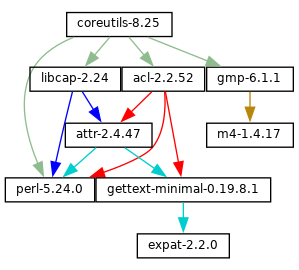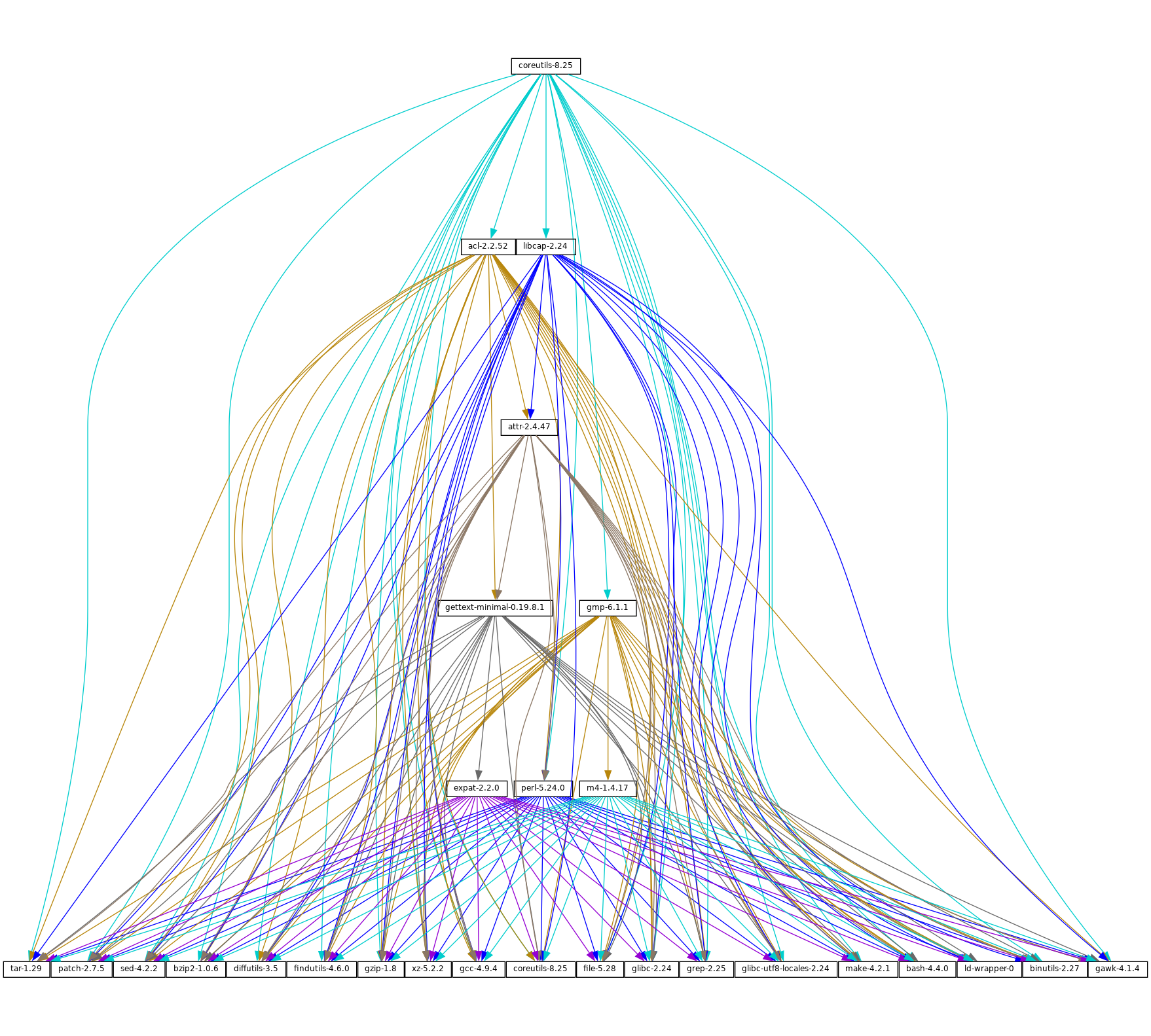Próximo: Invocando guix publish, Anterior: Invocando guix size, Acima: Utilitários [Conteúdo][Índice]
9.10 Invocando guix graph
Packages and their dependencies form a graph, specifically a directed
acyclic graph (DAG). It can quickly become difficult to have a mental model
of the package DAG, so the guix graph command provides a visual
representation of the DAG. By default, guix graph emits a DAG
representation in the input format of Graphviz, so its output can be passed directly to the dot command
of Graphviz. It can also emit an HTML page with embedded JavaScript code to
display a “chord diagram” in a Web browser, using the
d3.js library, or emit Cypher queries to construct
a graph in a graph database supporting the
openCypher query language. With
--path, it simply displays the shortest path between two packages.
The general syntax is:
guix graph opções pacote…
For example, the following command generates a PDF file representing the package DAG for the GNU Core Utilities, showing its build-time dependencies:
guix graph coreutils | dot -Tpdf > dag.pdf
The output looks like this:

Nice little graph, no?
You may find it more pleasant to navigate the graph interactively with
xdot (from the xdot package):
guix graph coreutils | xdot -
But there is more than one graph! The one above is concise: it is the graph
of package objects, omitting implicit inputs such as GCC, libc, grep, etc.
It is often useful to have such a concise graph, but sometimes one may want
to see more details. guix graph supports several types of graphs,
allowing you to choose the level of detail:
packageThis is the default type used in the example above. It shows the DAG of package objects, excluding implicit dependencies. It is concise, but filters out many details.
reverse-packageThis shows the reverse DAG of packages. For example:
guix graph --type=reverse-package ocaml
... yields the graph of packages that explicitly depend on OCaml (if you are also interested in cases where OCaml is an implicit dependency, see
reverse-bagbelow).Note that for core packages this can yield huge graphs. If all you want is to know the number of packages that depend on a given package, use
guix refresh --list-dependent(veja --list-dependent).bag-emergedThis is the package DAG, including implicit inputs.
For instance, the following command:
guix graph --type=bag-emerged coreutils
... yields this bigger graph:

At the bottom of the graph, we see all the implicit inputs of gnu-build-system (veja
gnu-build-system).Now, note that the dependencies of these implicit inputs—that is, the bootstrap dependencies (veja Inicializando)—are not shown here, for conciseness.
bagSimilar to
bag-emerged, but this time including all the bootstrap dependencies.bag-with-originsSimilar to
bag, but also showing origins and their dependencies.reverse-bagThis shows the reverse DAG of packages. Unlike
reverse-package, it also takes implicit dependencies into account. For example:guix graph -t reverse-bag dune
... yields the graph of all packages that depend on Dune, directly or indirectly. Since Dune is an implicit dependency of many packages via
dune-build-system, this shows a large number of packages, whereasreverse-packagewould show very few if any.derivationThis is the most detailed representation: It shows the DAG of derivations (veja Derivações) and plain store items. Compared to the above representation, many additional nodes are visible, including build scripts, patches, Guile modules, etc.
For this type of graph, it is also possible to pass a .drv file name instead of a package name, as in:
guix graph -t derivation $(guix system build -d my-config.scm)
moduleThis is the graph of package modules (veja Módulos de pacote). For example, the following command shows the graph for the package module that defines the
guilepackage:guix graph -t module guile | xdot -
All the types above correspond to build-time dependencies. The following graph type represents the run-time dependencies:
referencesThis is the graph of references of a package output, as returned by
guix gc --references(veja Invocandoguix gc).If the given package output is not available in the store,
guix graphattempts to obtain dependency information from substitutes.Here you can also pass a store file name instead of a package name. For example, the command below produces the reference graph of your profile (which can be big!):
guix graph -t references $(readlink -f ~/.guix-profile)
referrersThis is the graph of the referrers of a store item, as returned by
guix gc --referrers(veja Invocandoguix gc).This relies exclusively on local information from your store. For instance, let us suppose that the current Inkscape is available in 10 profiles on your machine;
guix graph -t referrers inkscapewill show a graph rooted at Inkscape and with those 10 profiles linked to it.It can help determine what is preventing a store item from being garbage collected.
Often, the graph of the package you are interested in does not fit on your
screen, and anyway all you want to know is why that package actually
depends on some seemingly unrelated package. The --path option
instructs guix graph to display the shortest path between two
packages (or derivations, or store items, etc.):
$ guix graph --path emacs libunistring emacs@26.3 mailutils@3.9 libunistring@0.9.10 $ guix graph --path -t derivation emacs libunistring /gnu/store/…-emacs-26.3.drv /gnu/store/…-mailutils-3.9.drv /gnu/store/…-libunistring-0.9.10.drv $ guix graph --path -t references emacs libunistring /gnu/store/…-emacs-26.3 /gnu/store/…-libidn2-2.2.0 /gnu/store/…-libunistring-0.9.10
Sometimes you still want to visualize the graph but would like to trim it so
it can actually be displayed. One way to do it is via the
--max-depth (or -M) option, which lets you specify the
maximum depth of the graph. In the example below, we visualize only
libreoffice and the nodes whose distance to libreoffice is at
most 2:
guix graph -M 2 libreoffice | xdot -f fdp -
Mind you, that’s still a big ball of spaghetti, but at least dot
can render it quickly and it can be browsed somewhat.
The available options are the following:
- --type=type
- -t tipo
Produce a graph output of type, where type must be one of the values listed above.
- --list-types
Lista os tipos de grafos disponíveis.
- --backend=backend
- -b backend
Produce a graph using the selected backend.
- --list-backends
Lista os backends de grafos disponíveis.
Currently, the available backends are Graphviz and d3.js.
- --path
Display the shortest path between two nodes of the type specified by --type. The example below shows the shortest path between
libreofficeandllvmaccording to the references oflibreoffice:$ guix graph --path -t references libreoffice llvm /gnu/store/…-libreoffice-6.4.2.2 /gnu/store/…-libepoxy-1.5.4 /gnu/store/…-mesa-19.3.4 /gnu/store/…-llvm-9.0.1
- --expression=expr
- -e expr
Considere o pacote que expr avalia.
This is useful to precisely refer to a package, as in this example:
guix graph -e '(@@ (gnu packages commencement) gnu-make-final)'
- --system=sistema
- -s sistema
Display the graph for system—e.g.,
i686-linux.The package dependency graph is largely architecture-independent, but there are some architecture-dependent bits that this option allows you to visualize.
- --load-path=directory
- -L diretório
Add directory to the front of the package module search path (veja Módulos de pacote).
This allows users to define their own packages and make them visible to the command-line tools.
On top of that, guix graph supports all the usual package
transformation options (veja Opções de transformação de pacote). This makes
it easy to view the effect of a graph-rewriting transformation such as
--with-input. For example, the command below outputs the graph of
git once openssl has been replaced by libressl
everywhere in the graph:
guix graph git --with-input=openssl=libressl
So many possibilities, so much fun!